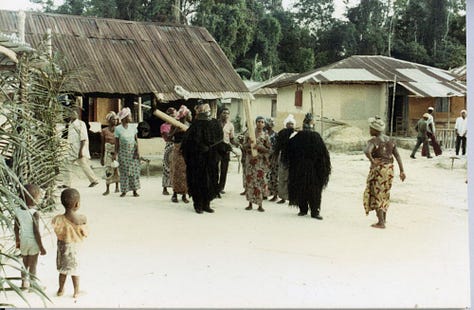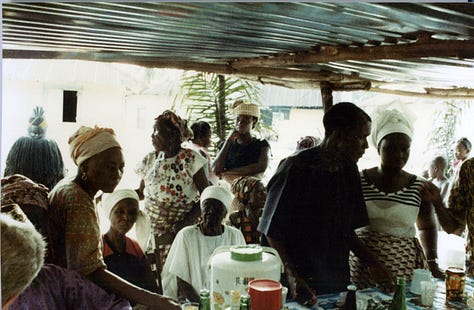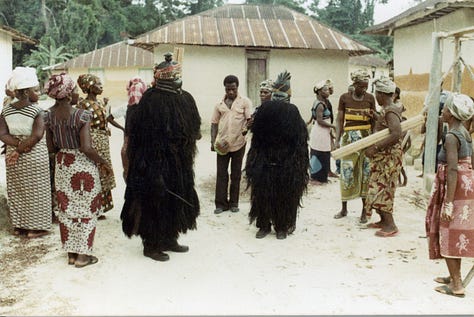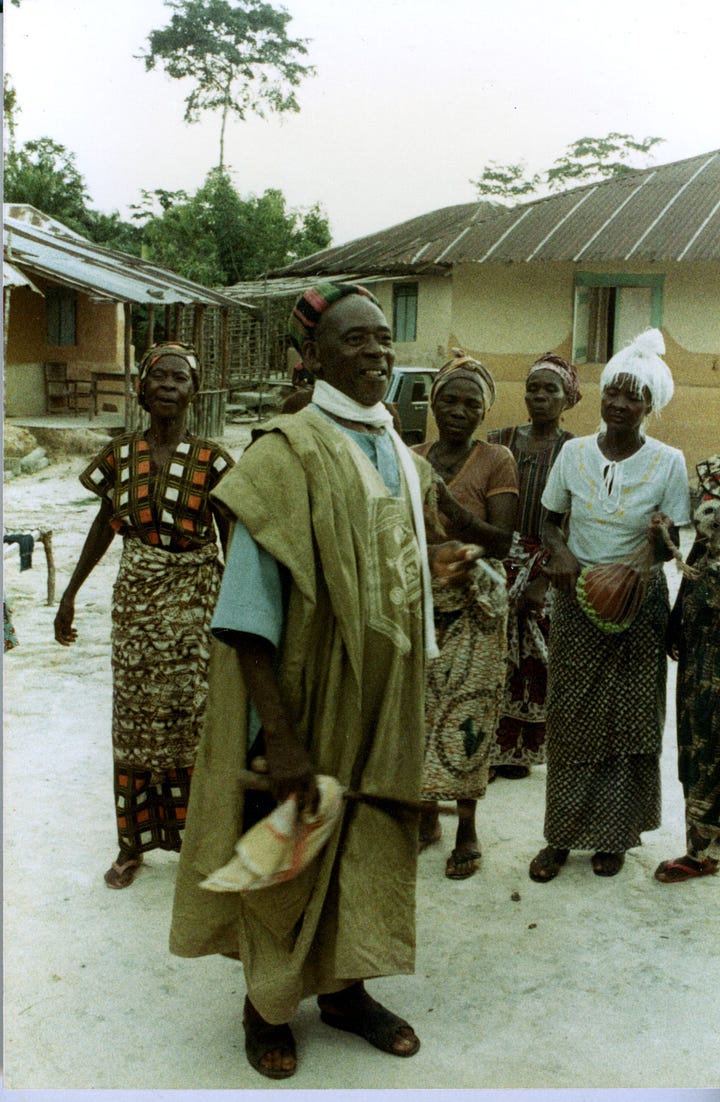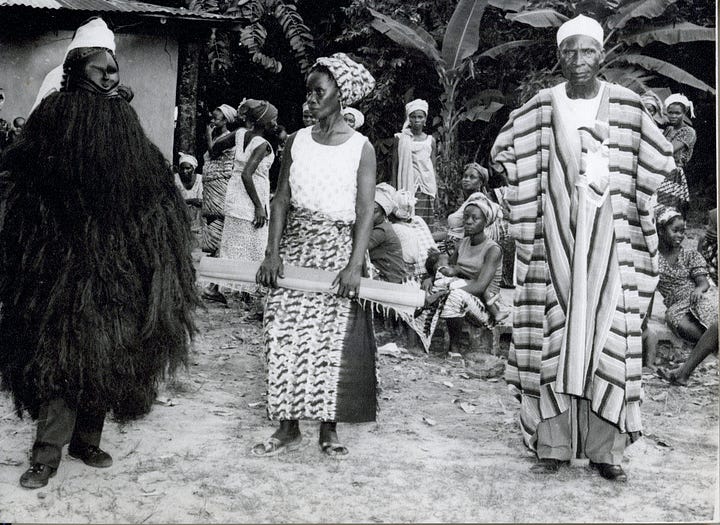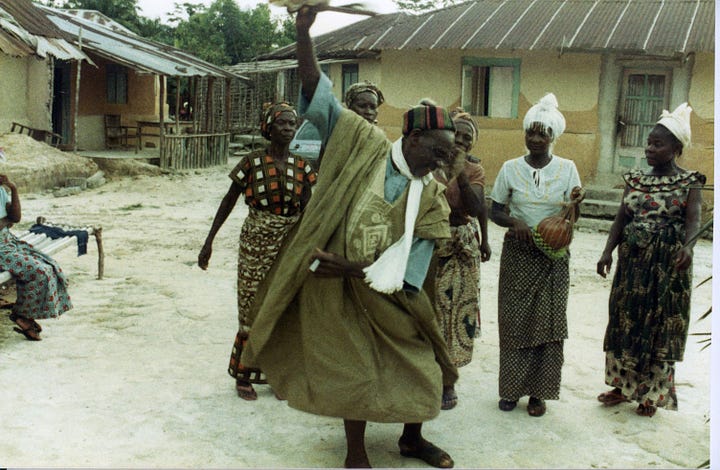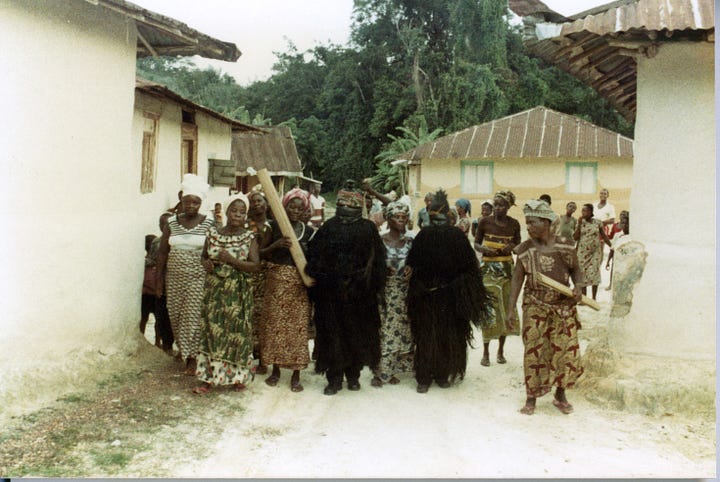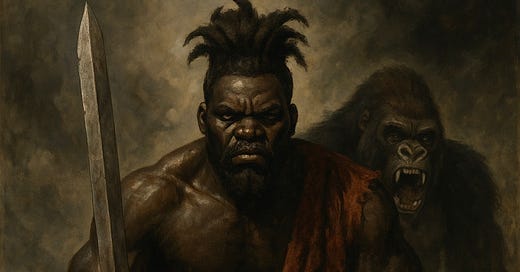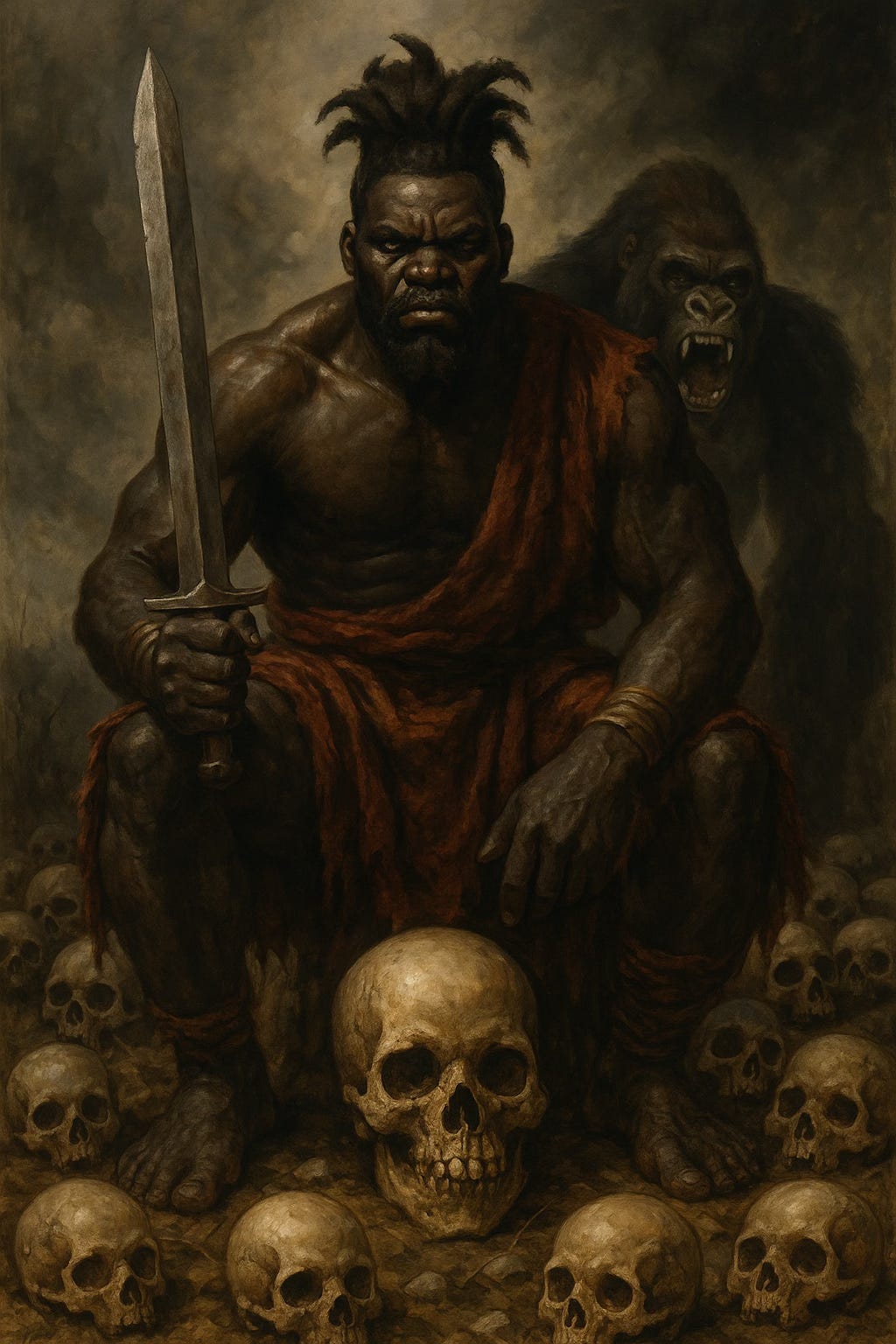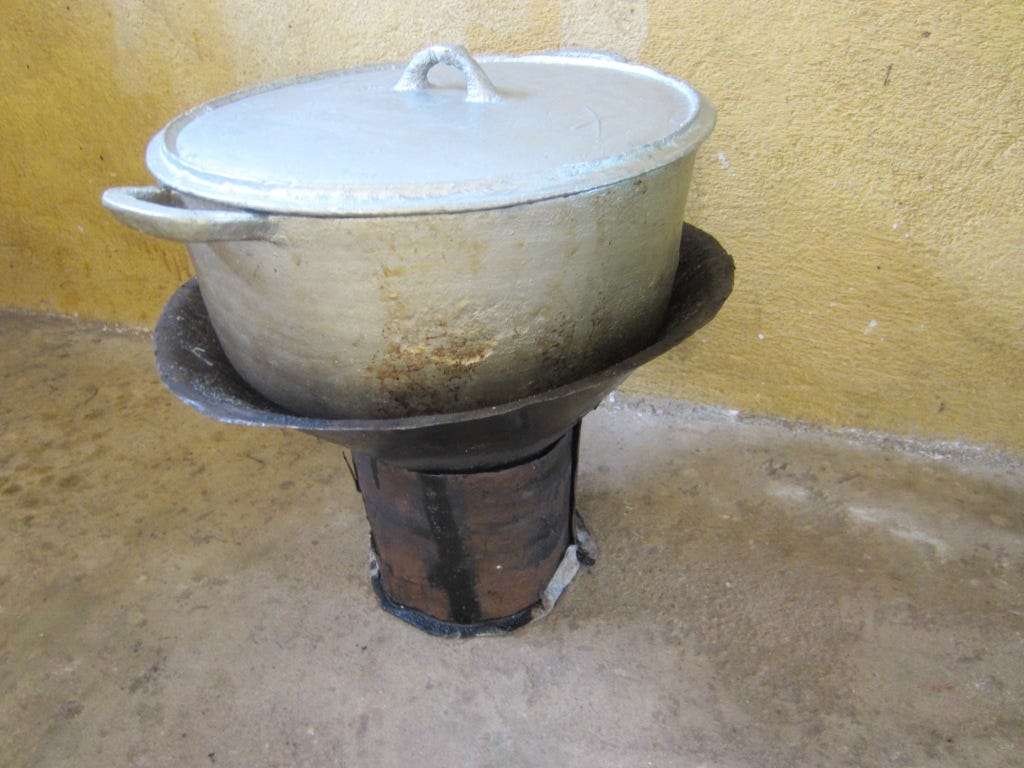KPOMAKPƆLƆ: The Gola King Who Fought Beside a Gorilla
A Retelling of Gola Oral History from the 1800s
Amidst the "100 Men vs. Gorilla" Debates: Why Kpomakpɔlɔ’s Story Matters
In recent internet debates—sparked by jokes over whether “100 men could take down a gorilla”—a mythologized image of raw human strength versus nature has captured imaginations. Yet among the Gola, an ancestor’s union with a great gorilla spirit is far more than fanciful banter; it underpins the legend of King Jaa Sei, alias Kpomakpɔlɔ, who marshaled both prayer and steel to safeguard his people (oral history). By tracing this oral tradition, we honor a history eclipsed by colonial archives and correct misconceptions born of viral memes. Let’s journey into the heart of Gola territory, where sacred rivers whisper secrets and skulls of enemies still haunt the soil. The Gola People: Guardians of the Forest.
Note: This retelling is based on "The Traditional History and Folklore of the Gola Tribe in Liberia" by S. Jangaba M. Johnson, as recounted by the elders of the Kpo Clan in the 1960s.
The original Gola heartland comprised the rainforests and river valleys from modern-day Brewerville—on the edge of Monrovia—northward along sacred waterways to Kongbah, and across the Sierra Leone border. Over centuries they organized into chiefdoms and clans, practicing mixed economies of rice farming, hunting, and riverine trade.
The Kpo Clan: Birth of a Warrior Dynasty
The Kpo Clan is currently located in Klay District, Bomi County, Liberia. Principal towns in the Kpo Clan are:
• Klè : Klay (The 3rd Largest Town in Bomi County)
• Ɓɛ Sié : Seah Town (The clan HQ for the Poro and Sande/Bimba)
• Gɔ̀ɔ̀ŋ Zìpo : Gohn Zipo (A notorious town associated with witchcraft)
Foundations of the Kpo Clan
Da Kpo Sola’s Vision
A hunter from the neighboring Dei group, Da Sola journeyed to a mountainous site called Taawe in the early 1800s. Enchanted by its lush stands of oil palm and hardwood, he relocated his family from Boinwoin and established the first settlement—Kpo—naming it for the mountain that loomed above (oral history).Revival of Seah Town (Ɓɛ Sié)
Jaa Zowai, a prosperous refugee from Juodi, fled conspiracies against him and found refuge with Da Kpo Sola. Near a deserted Dei village, he rebuilt Sié Bli, the Poro society’s capital, earning the title Baa Sié (“Father of Sié”). As the population adopted Gola language and customs, both town and title became Ɓɛ Sié and Dà Sié respectively (oral history).Birth of Klè (Klay)
A hunter named Koi scouted a hill at the mountain’s foot and proposed a rice farm. Over seasons he built barns, and by mid-19th century a permanent settlement—Klè —had formed, poised to become the clan’s military and administrative center (oral history).
Tuo: Matriarchal Power and the Price of Audacity
Dà Sié’s daughter Tuo inherited her father’s wealth and status, assuming uncontested leadership of the clan upon his death. Yet when the time came to institute the Sande (Bimba) society’s final feast—strictly a male prerogative—she independently organized the ceremony. This unprecedented breach of custom sparked outrage among neighboring male rulers, who likened her act to “the crowing of a hen” and plotted her death (oral history).
Tuo’s only daughter, Jande Maatɔɔ, was married into the royal line of Senjeh. Seeking protection, Tuo fled to Tinje under the aegis of her son-in-law Gombla. Through diplomatic intrigue, he persuaded the aggrieved chiefs to rescind her death sentence in exchange for a heavy fine. Victorious, Tuo returned home and, recognizing the need for a warrior to unite the clan, dispatched emissaries for her estranged brother Jaa Sei, setting the stage for the next chapter (oral history).
Kpomakpɔlɔ’s Journey: From Exile to Warlord
Family Feuds
Da Kpo Sola’s lineage thrived, but power struggles brewed. His descendant, Da Sié, had two notable children: Tuo, a shrewd matriarch, and Jaa Sei, a restless young man. When Da Sié died, Tuo seized control, sidelining her brother. Disillusioned, Jaa Sei fled to Millsburg on the Saint Paul River, where he lived with the Peal family, honing his skills as a hunter. It was here that Jaa Sei’s legend began. He married a woman from Goije Plahn, a riverside town, and became renowned for his unmatched marksmanship.
Tuo’s Rebellion and the Call Home
Back in Ɓɛ Sié, Tuo’s ambition nearly cost her life. Defying tradition, she hosted her father’s Poro Society feast—a role reserved for men. Outraged male leaders conspired to kill her, comparing her act to “a hen crowing.” Tuo fled to her son-in-law Gombla, a prince of Senjeh, who negotiated her pardon with a hefty fine. Humbled, she summoned Kpomakpɔlɔ home, recognizing that only his strength could protect their clan.
The Return of Kpomakpɔlɔ: From Exile to Warrior King
Upon receiving his sister Tuo's summons, Jaa Sei, now matured and seasoned by his experiences, returned to his homeland. Embracing his Gola identity, he took residence in the burgeoning town of Klè (Klay), founded by the hunter Koi. The name "Klè" in Gola translates to "dare," symbolizing Jaa Sei's challenge to any adversary: "I will sit right on this hill and await any aggressor that might want to attack me. Whosoever dares to come, let him come."
The Origin of the Name Kpomakpɔlɔ
Jaa Sei's exceptional hunting skills earned him the affectionate nickname "Kpomakpɔlɔ." In Gola, "Kpo" means "pot," and "kpɔlɔ" refers to "soup." The moniker arose when his wife, proud of her husband's consistent provision of meat, declined invitations to fish with other women, stating, "What need do I have to go fishing when my husband is always bringing meat for me?" The women, acknowledging her contentment, remarked, "She has her soup pot," leading to the enduring name Kpomakpɔlɔ.
Fortifying Klè: The Spiritual Shield of Baa Monya
Upon establishing himself in Klè, Kpomakpɔlɔ recognized the need for spiritual fortification to protect his burgeoning settlement. He sought the expertise of Baa Monya, a renowned Mandingo Muslim seer known for his profound spiritual insights. Baa Monya, whose name translates to "Father Monya," was a man of mixed heritage, born to a Mandingo father and a Dei mother. After the passing of his parents, he returned to his maternal homeland, bringing with him a wealth of spiritual knowledge.
To safeguard Klè, Baa Monya performed intricate rituals, invoking protective spirits and embedding charms into the very soil of the town. Central to this fortification was a ceremony where Kpomakpɔlɔ sat on the ground while a massive rock was held above his head. Upon completion, the charm was buried at that exact spot, and the heavy rock was suspended atop four smaller stones, symbolizing the town's resilience. This sacred structure remains in Klè to this day, a testament to the spiritual shield that Baa Monya bestowed upon the town.
The Women's Defiant Chant: "Kɔ̀à mì o Klè o"
This song, sung by Gola women, encapsulates the awe and reverence held for Kpomakpɔlɔ and the fortified town of Klè.It was a challenge to their husbands, daring them to prove their masculinity by taking them to Klè, a place synonymous with strength and fearlessness.
Call: Kɔ̀à mì o Klè o – Carry me to Klè
Response: A yeŋge dììŋ –
Call: Se mù nɔ̃ŋ folaa, Kɔ̀à mì o Klè o – If you are a man, carry me to Klè
Response: A yeŋge dììŋ –
Call: Máŋ gbàma Klè mààŋ gbo-máŋ-ɗùà – The guns of Klè sound like cannons
Response: A yeŋge dììŋ –
This chant not only highlights the martial prowess of Klè but also serves as a testament to Kpomakpɔlɔ's indomitable spirit.
The Gorilla Guardian: A Supernatural Ally in Battle
Legends speak of a formidable gorilla residing in the mountains overlooking Klè, believed to be spiritually linked to Kpomakpɔlɔ. This colossal creature, revered and feared, was said to emerge during times of conflict, fighting alongside the warriors of Klè. Its presence on the battlefield was both awe-inspiring and terrifying, turning the tide of battles and instilling fear in the hearts of enemies. The gorilla's alliance with Kpomakpɔlɔ symbolized a harmonious bond between man and nature, a union of strength and spirit. After Kpomakpɔlɔ's passing, sightings of the gorilla ceased, but its legend endures, echoing through the oral histories of the Gola people.
The Betrayal and Execution of Yonga Daaya
Among the many tales of Kpomakpɔlɔ's reign, the story of Yonga Daaya stands out as a poignant lesson in betrayal and justice. Yonga Daaya, once a trusted associate, committed a grave transgression by engaging in an illicit affair with one of Kpomakpɔlɔ's wives, resulting in a child. Kpomakpɔlɔ, demonstrating restraint, chose not to act immediately. However, Yonga Daaya's betrayal deepened when he led an armed assault against Klè. The attack failed, and Yonga Daaya was captured.
In accordance with the customs of the time, he was taken to Goundoi, a designated execution site by the creek Daijua. There, in a solemn ceremony, Yonga Daaya was beheaded, his blood mingling with the waters of the creek. This act served as a stark warning to others, emphasizing the consequences of treachery and the unwavering commitment of Kpomakpɔlɔ to uphold justice.
The Bones of Gbundoi: A Testament to Valor
The aftermath of Kpomakpɔlɔ's numerous battles left indelible marks on the landscape of Klè. At the outskirts of the town and near Gbundoi by the creek Duaijua, piles of bones and skulls stood as grim reminders of the countless enemies who fell in battle. These macabre monuments were not merely trophies but served as deterrents, signaling the might of Klè and the futility of opposition. While some of these remains have been respectfully relocated in recent times, others remain, silently narrating tales of valor and the fierce defense of the Gola homeland.
Vombo Totai: From Condemned Captive to Esteemed Poro Chief
In the annals of Gola history, few narratives resonate as profoundly as that of Vombo Totai—a tale of transgression, redemption, and ultimate honor.
The Betrayal
Vombo Totai, once a trusted associate within Kpomakpɔlɔ's inner circle, committed a grievous betrayal by engaging in an illicit affair with one of Kpomakpɔlɔ's wives, resulting in a child. Kpomakpɔlɔ, demonstrating restraint, chose not to act immediately. However, Vombo Totai's betrayal deepened when he led an armed assault against Klè. The attack failed, and Vombo Totai was captured.
The Plea for Mercy
Facing execution, Vombo Totai composed and performed a poignant song on the eve of his death. His lyrics, filled with vulnerability and remorse, resonated deeply with Kpomakpɔlɔ. Moved by the sincerity of the song, Kpomakpɔlɔ granted Vombo Totai clemency.
Chorus:
Vombo-o Totai
Verses:
Dìe a nyɛnɛ Totai? – What would they do with Totai?
Ko a kɔ̀à Totai? – Where would they carry Totai?
Jiʋa a jiʋe Totai? – Would they kill Totai?
Gɔ̀ɛ̀ɛ a gɔ̀ɛ̀ɛ Totai? – Would they drag Totai?
Deka a deka Totai? – Would they tie Totai?
Bulo a bulo Totai? – Would they tie Totai?
Daŋge a daŋga Totai? – Would they release Totai?
Redemption and Honor
Embracing his second chance, Vombo Totai pledged loyalty and sought to atone for his misdeeds. He requested to lead a campaign against Kpomakpɔlɔ's adversaries. Demonstrating valor and strategic acumen, Vombo Totai's efforts were instrumental in securing victory. In recognition of his bravery and renewed allegiance, he was appointed as a Poro chief—a position of immense respect and responsibility within Gola society.
The Enduring Legacy of Kpomakpɔlɔ
Kpomakpɔlɔ's influence extends beyond his lifetime, with his descendants continuing to honor his legacy. The surname "Kpomakpor," an evolution of "Kpomakpɔlɔ," is proudly borne by many, signifying a lineage of strength, resilience, and leadership. Families such as the Kpodie, Kpofua, and Maana Kpo trace their roots to this legendary figure, preserving the rich traditions and stories of the Gola people.
Epilogue: Echoes of the Past
While gorillas no longer roam the forests of Liberia, their memory endures through tales like that of Kpomakpɔlɔ. These narratives, interweaving human courage with the majesty of nature, serve as cultural touchstones, reminding us of a time when man and beast stood united. As we reflect on these stories, we are called to honor and preserve the rich heritage of the Gola people, ensuring that the legends of Kpomakpɔlɔ and his gorilla guardian continue to inspire future generations
